Arcerion Parachute Regiment: Difference between revisions
mNo edit summary |
|||
| Line 125: | Line 125: | ||
Exchange programs exist for Stenzan and Arcer officers and senior enlisted personnel to spend time with their foreign counterpart, filling squad, platoon or company leadership and staff positions. This program, called the Stenzan-Arco Leadership Growth Program, allows leaders to grow by adapting to a leadership environment they would not normally be exposed to. Stenza's parachute divisions offer opportunities within this program to members of the Paras. | Exchange programs exist for Stenzan and Arcer officers and senior enlisted personnel to spend time with their foreign counterpart, filling squad, platoon or company leadership and staff positions. This program, called the Stenzan-Arco Leadership Growth Program, allows leaders to grow by adapting to a leadership environment they would not normally be exposed to. Stenza's parachute divisions offer opportunities within this program to members of the Paras. | ||
[[Category: IXWB]] | |||
[[Category: 2022 Award winning pages]] | |||
[[Category: Military]] | |||
Revision as of 09:49, 30 December 2022
| Arcerion Parachute Regiment | |
|---|---|
| APR | |
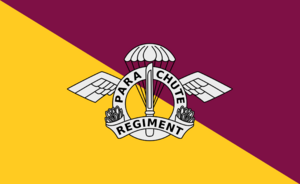 | |
| Active | 19??-present |
| Country | Arcerion |
| Type | |
| Role | Expeditionary Warfare Airborne Infantry Air Assault |
| Size | 1,500 (2026) |
| Part of | 11 Parachute Brigade |
| Garrison/HQ | Novasar Barracks, Presdale Garrison |
| Motto(s) | "First in the Fight" |
| Anniversaries | 19?? (Regimental Founding) 19?? (Ardmori Civil War) 19?? (Battle of Novasar Airfield) September 30, 1961 (Iraso Pocket) |
| Engagements | Arcer Bush Wars, First Great War, Ardmori Civil War, Second Great War, Istrenyan Crisis, Final War of the Deluge |
| Commanders | |
| Commanding Officer | LCol Timothy MacAile |
| Regimental Sergeant-Major | WO1 Paul Truss |
Overview The Arcerion Parachute Regiment (APR), commonly known as the Paras, is a Regular Force airborne infantry regiment of the Arcer Army, headquartered at the Novasar Barracks, located at the Presdale Garrison in the Arcer Heartland, Northern Northlea Governorate. Its current commanding officer is Lieutenant-Colonel Timothy MacAile, and the Regimental Sergeant-Major is WO1 Paul Truss. The Arcerion Parachute Regiment is part of the Arcer Army's 11 Parachute Brigade.
The Parachute Regiment was formed in the Interwar Period with the identified need to stand up a parachute capability for the Army, following a White Paper by the Arcer General Staff on the future of elite infantry formations. At its largest, it had a dozen battalions during the Second Great War, and formed the core of the 1st Airborne Division. The Regiment has taken part in every major Arcer conflict since its inception, from its key role in Operation Lightfoot, to the Final War of the Deluge against Varshan.
The regiment took on its current configuration and organization after the conclusion of the Second Great War as defense reforms slashed budgets and downsizing of the Armed Forces became a national priority. The Regiment has consistently proved to be a key asset to the Arcer Armed Forces, where it is often deployed for counter-insurgency, policing, stability, and humanitarian missions due to its highly mobile nature and maintaining a high level of readiness. As per the 2022 Confederate Memo on Defence the Parachute Regiment was slated to receive the funding and manning to raise an extra two battalions by 2028, and a further third new battalion (6 PARA) by 2030.
Formation
In light of massive industrialization of warfare and an increased emphasis on the professionalization of the Armed Forces of Arcerion, the Arcer General Staff outlined a new need for a highly-mobile airborne force of infantry that could seize airfields, ports, and key transportation hubs ahead of the advancing main ground forces from the Arcer Army. The General Staff identified that an existing infantry unit, the Duke of Lincolnshire's Regiment, headquartered at Presdale Garrison, would provide the nascent headquarters and training staff to begin forming the new regiment. Considerable efforts were also made by the Arcer Air Force to prepare for the troop lift that would be required to airlift multiple battalions. The Air Force started Combat Controller Parties, small groups of aviators that would integrate with the Army to assist with the air dropping of men, equipment, and ammunition onto drop zones.
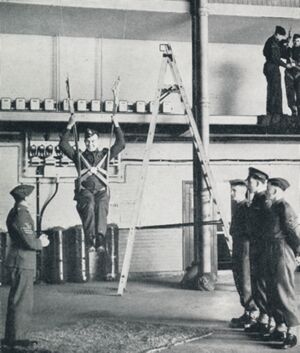
Training and Equipment
The Parachute course itself took place over fourteen days at the Parachute School (later renamed to the Arcer Army Airborne School). Candidates had to jump from converted hot air balloons as the Air Force had no sufficient air transport aircraft available. A required five jumps was the minimum standard to be qualified as an airborne soldier, with the jumps gradually increasing in difficulty from no equipment, up to full equipment at night. During this period, Army records stated that volunteers failed from the course at an approximate 40% rate due to the unnatural type of training, fear of heights, injury, or failure to meet standards. Volunteers were often motivated by the Jump Pay that was awarded to successful candidates.
The follow-on training was sixteen weeks of additional exposure to small arms, heavy weapons, explosives, radios and transmission equipment, weather forecasting, escape and evasion, close quarters combat techniques, and a large physical fitness component. Specific emphasis was placed on the section and platoon level tactics, as Arcer Paras would be expected to fight in small disparate groups in the event of large dispersion on a drop zone.
History
First Great War
The Regiment from where the Paras gain their lineage, the Duke of Lincolnshire's Regiment, fought in the First Great War as part of the Arco-Paul Conflict. They mainly conducted patrols and defensive operations in Eastern Arcerion, as part of the blocking action to defend against Paulastran forces attempting to attack Arcerion through Washakara. They fought primarily against the 2nd and 3rd Infantry Divisions from the Paulastran Army, and the Regimental War Diary, as well as reports from the Arcer General Staff all gave high marks to the Regiment's officer and non-commissioned officer leadership.
The Regiment participated in the brief conflict, and solidified many of the tactics and standard operating procedures that would serve as the core training requirements of the Airborne Infantry course years later. Forced ruck marches, night fighting, marksmanship, and the ability to move equipment via man-portable methods over rough terrain like the Eastern Aileach Mountains highlighted the requirement for soldiers to be educated, extremely physically fit, and aggressive.
With the conclusion of the Arco-Paul conflict of the First Great War, the Regiment was moved from its home garrison in Dalfearn, to the more Northern garrison of Presdale, where it would remain to police the Northern Arcer border areas, remaining in its garrison state until reformed into the Arcerion Parachute Regiment.
Ardmori Civil War
TBC
Second Great War
See Also: Operation Lightfoot The Arcerion Parachute Regiment's first large-scale and sustained combat operations after the Ardmori Civil War came with the invasion of the Cape in Operation Lightfoot. Arcer paratroopers, numbering twelve total battalions, invaded the Cape as part of the preparing phase to seize key road junctions, railheads, radio stations, and other key government buildings to enable success for the amphibious invasion. At all Drop Zones, Arcer Paratroopers would drop into Capetian-held territory, slowly fighting into the hills and areas surrounding their initial objectives. The overall result of the operation was a series of key battles that defined the Paras, such as the Battle for Novasar Airfield and the Battle for Hill 334.
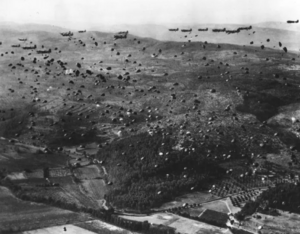
The Battle for Novasar Airfield, for which the Regimental Barracks and Headquarters is named, saw elements of the 1st Airborne Divison's HQ as well as disparate elements of two battalions engage a Capetian force of regulars, reservists, and light armour formations. Extremely fierce fighting using recoilless rifles, heavy machineguns, and mortars badly mauled both sides, however the Paras overcame and secured the objective, which allowed following members of the Royal Arcerion Engineers to clear, repair, and return the airstrip to operational condition. The Arcer Air Force was able to stage strike aircraft and maintenance personnel at Novasar, greatly contributing to the success of the armoured and mechanized offensives as they benefitted from the shorter turn-around time of close air support sorties. At Hill 334, the 4th Parachute Battalion successfully secured a key operational objective, which overlooked a major river and several bridges and river fords that were key to allowing the 2nd Division of the Arcer Army to advance towards Cape Town. Despite losing over half its officers and other ranks (killed or wounded) the Paras secured Hill 334 and proved again the value of elite infantry formations in enabling larger operational maneuvers. The legacy of the Second Great War on the Paras was a defining moment in Regimental History. It was the largest the Regiment would expand to, with twelve battalions plus staff, schools, and facilities, and is likely seen as the 'Golden Age' of the Regiment. Much of the current Paras' heritage is drawn from the Second Great War, including the current Regimental Lines, at Novasar Barracks.
Istrenyan Crisis
With the growing hostilities and tensions in Istrenya growing in 1959-1960, 11 Parachute Brigade, centered around the Parachute Regiment, was staged at a trio of airfields outside of Chester-on-Moore, and made preparations for an airdrop into Istrenya upon successful seizure of M'Kelo Airport outside of the large town of Mogtepeni. Despite insistence from Army Headquarters and the Arcer General Staff, the Confederate Parliament and Prime Minister's Office disallowed the use of 11 Para for an opposed landing, even though intelligence estimates had estimated there was limited amounts of anti-aircraft artillery or heavy weapons to prevent 11 Para, or the Parachute Regiment itself, from seizing the airstrip. On July 24th, with 7 Rifle Brigade having a tentative grip on the airfield, the Regiment was inserted along with other airborne battalions in the Brigade. 11 Parachute Brigade then proceeded to fight up the length of Highway 3, commonly referred to by Second Great War veterans as 'The Long March North,' to the outskirts of Iraso. After several weeks of sustained urban fighting in Iraso and its smaller townships nearby, the Parachute Regiment finally broke through on September 30th to reach the Arcer Consulate in the City Centre, relieving members of the Arcerion Commando Regiment along with consular and diplomatic staff.
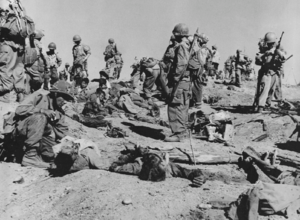
The Brigade was withdrawn by the end of January 1961 along with thousands of other Arcer troops, and reconstituted in Chester-on-Moore before they returned to the Novasar Barracks for a refit phase, having taken casualties during the course of Op Insolent.
Fourth Bush War
Vietnam-esque
Final War of the Deluge
See Also: Operation Pullman
Kelekona Peacekeeping
The Arcer Army has deployed the Regiment twice on peacekeeping operations to Operation Redoubt, the Arcer commitment to peacekeeping and stability operations during the reconstruction of Kelekona. The Regiment was not slated for high readiness in 2026, as it had just finished a deployment to the Northwestern Border Security Zone as part of the Arcer government's ongoing counter-insurgency and counter-terrorism mission there. However, with the need for rapidly deployable light expeditionary forces to help quell an increase in fighting between the Maktalin Government and the Alsek Clique, the Parachute Regiment rapidly prepared to deploy again, spending seven months along the Kelo-Telo Border Region. There was a significant amount of fighting that the Paras had to undergo as they fought to establish Patrol Base 3 - the Northernmost fighting and sustainment base in the Arcer-patrolled Eastern peacekeeping Zone. The Regiment suffered roughly three dozen casualties, with LCpls John Smythe and Brandon McCullough both being killed in a roadside bomb incident by Arzalist Rebels.
The Regiment conducted its second deployment in 2028, as part of a regularly scheduled high readiness deployment. All three battalions rotated into Kelekona, based out of FOB Maktalin as well as Patrol Base 3, and were assigned missions to push the peacekeeping boundary further North, working with civil affairs and non-governmental organizations to provide clean well water, schooling, and improved infrastructure. During the deployment, the Regiment relied on close air support from the Arcer Air Force, as well as regularly liaised with members of the Arcer Special Operations Command, supporting their ongoing counter-terror mission against former members of the Varshani government still wanted for war crimes and crimes against humanity hiding in Kelekona.
Structure

Regimental Organisation
The current Regimental structure, since 2022 is as follows:
- Headquarters, The Arcerion Parachute Regiment (Duke of Lincolnshire's), Novasar Barracks, Presdale Garrison
- 1st Battalion, APR, Novasar Barracks, Presdale Garrison, Companies A-D
- 2nd Battalion, APR, Novasar Barracks, Presdale Garrison, Companies E-H
- 3rd Battalion, APR, Novasar Barracks, Presdale Garrison, Companies I-L
- 4th Battalion, APR, Dalfearn Garrison, Slated to be Operational by 2028
- 5th Battalion, APR, Dalfearn Garrison, Slated to be Operational by 2028
- 'T' Company (Battle of M'Kelo), Cadre and Training, Attached to Arcer Army Airborne School
Each battalion consists of three to four companies of parachute infantry, an integral combat support company with mortars, direct fire support, and light ISR assets (UAS), receiving its logistics from a service and support company co-located with Battalion headquarters. There is also an integral attached Combat Control Platoon attached from the Arcer Air Force as past of Regimental Headquarters.
The secondary duty of many NCOs and Officers is to serve terms as instructors and staff/cadre for the permanent school facilities in Arcerion such as the Arcer Army Airborne School and the Royal Arcer Advanced Warfare School.
Facilities

Arcer Army Airborne School (AAAS)
The Arcer Army Airborne School, commonly referred to as Jump School, is the only military parachute facility remaining in the Arcer military. It is staffed with a cadre of officers and NCOs from the Parachute Regiment, and regularly runs both Basic Parachute Courses (BPC) as well as Advanced Parachute Courses (APCs). It is the core of the Parachute Regiment's ability to generate new paratroopers, and has been in continuous operation since 1919. Every year it qualifies several hundred new members of the Arcer Armed Forces to perform static-line, freefall, and jumpmaster duties. It is housed at the Smythe Lines, named after LCpl John Smythe, killed in Kelekona while peacekeeping. The AAAS also regularly hosts paratroopers and instructor staff from XX and YY, as part of the ongoing Arcer commitment to military excellence and international partnerships through armed forces collaboration. The school follows three phases, Instruction Week, Tower/Hangar Week, and Jump Week. After three weeks, soldiers are qualified as basic army parachutists, and those wishing to pursue employment as members of the Parachute Regiment may undergo the Airborne Infantry Course (16 weeks), to qualify as members of the Regiment. The Airborne School is also responsible for running the Airborne Infantry Course, which instructs soldiers on advanced fieldcraft, marksmanship, gunnery, small party leadership, explosives, and advanced airmobile techniques such as sling-loading helicopters and helocasting.
Royal Arcer Advanced Warfare School (RAAWS)
The Royal Arcer Advanced Warfare School is the primary method from which advanced infantry and soldiering techniques are taught to members of the Arcer Armed Forces. This includes courses for Senior Non-Commissioned Officers (usually Sergeants or Warrant Officers) such as Jumpmaster Courses, Pathfinder Courses, as well as Air Assault and helicopter lift courses. The RAAWS also works with Arcer Air Force institutions to ensure its Jumpmasters work with Air Force loadmasters to understand how to properly deploy an infantry company from a military cargo aircraft.
Novasar Barracks
The Regimental Lines, named after one of the Regiment's battles against The Cape, are situated in the Northern Half of Presdale Garrison, a central base of the Arcer Armed Forces in Northlea Governorate. It includes the Regimental Headquarters, the Officer's Mess, the Sergeant & Warrant Officer's Mess, the Junior Ranks Mess, Battalion and Company buildings for each subunit, as well as supporting structures for nearby units. The lines also include the Arcer Army Airborne School's jump tower, hanging practice harnesses, as well as instructional halls. The Advanced Warfare School has a separate compound, adjoined to the Regimental Lines. Of specific note is the converted Catholic Church, St. Michael's, which has been used for both Sunday Mass (Catholic as well as other denominations), as well as housing the Regimental Museum, which houses a large number of captured enemy weapons, flags, and other trophies brought back from the Regiment's storied campaigns.
Battle Honours
In the list below, battle honours in capitals were awarded for participation in large operations and campaigns, while those in lowercase indicate honours granted for more specific battles. Battle honours in bold type are authorized to be emblazoned on the regimental colours.
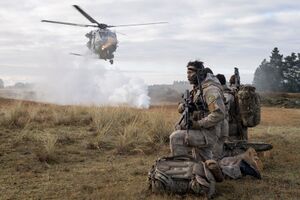
- First Great War, 1896-1902
- First Battle of Aileach
- Defense of Easthampton
- WASHAKARA
- Ardmore Campaign, 19XX-19YY
- Battle of XX
- Retreat from YY
- Battle of ZZ
- Second Great War, 1934-1943
- CAPETIAN PENINSULA
- Battle of Novasar Airfield
- Battle of Hill 334
- Retreat from Cape Town
- Istrenyan Crisis, 1959-1961
- M'Kelo Airport
- IRASO POCKET
- Battle of Sofrine
- Fourth Bush War, 1964-975
- Operation Terrace
- Operation Teflon
- Operation Kiln
- INNIS RIVER BASIN CAMPAIGN
- BORDER CAMPAIGN
- Final War of the Deluge
Lineage
- Duke of Lincolnshire's Militia, 1811
- Duke of Lincolnshire's Royal Militia, 1844
- Duke of Lincolnshire's Rifles, 1877
- Duke of Lincolnshire's Regiment, 1885
- Arcerion Parachute Regiment, 1916
Alliances
Stenza
Stenza's Army's two airborne divisions, the 6th "Rakahangan" and 7th "Winged Kiwis", frequently train with the Arcerion Parachute Regiment. Both the divisions' full time and part time components frequently cooperate with their Arcer counterparts, training airborne and infantry tactics in the different terrains of both Stenza and Arcerion. Statements from the Stenzan Ministry of Defense have described the cooperation between these units as "a shining example of Stenzan-Arco cooperation" and "evidence that soldiers from different cultures can come together to act as one in pursuit of a common goal. Stenzan military officials have commented that they consider the Stenzan units one hundred percent capable of operating with the Arcerion Parachute Regiment without any prior planning. Further cooperation between the Paras and Stenza's special forces exists.
Exchange programs exist for Stenzan and Arcer officers and senior enlisted personnel to spend time with their foreign counterpart, filling squad, platoon or company leadership and staff positions. This program, called the Stenzan-Arco Leadership Growth Program, allows leaders to grow by adapting to a leadership environment they would not normally be exposed to. Stenza's parachute divisions offer opportunities within this program to members of the Paras.